Business Research Methodology: Semi-Structured and In-Depth Interviews
VerifiedAdded on 2022/11/26
|6
|866
|418
Report
AI Summary
This report provides a comprehensive analysis of two primary interview techniques used in business research: semi-structured and in-depth interviews. It explores the advantages and disadvantages of each method, offering practical guidance on how to conduct these interviews effectively. The report highlights the benefits of semi-structured interviews, such as their flexibility and ability to gather comparable qualitative data, while also acknowledging their limitations in terms of objectivity. Similarly, it discusses the strengths of in-depth interviews, including their capacity to build rapport and uncover detailed insights, while addressing challenges such as time consumption and potential biases. The report also offers practical guidelines for conducting these interviews, including the importance of preparing questions, establishing rapport, and adapting to the flow of conversation. Finally, the report references several academic sources to support its findings and provide a robust understanding of these crucial research methods.
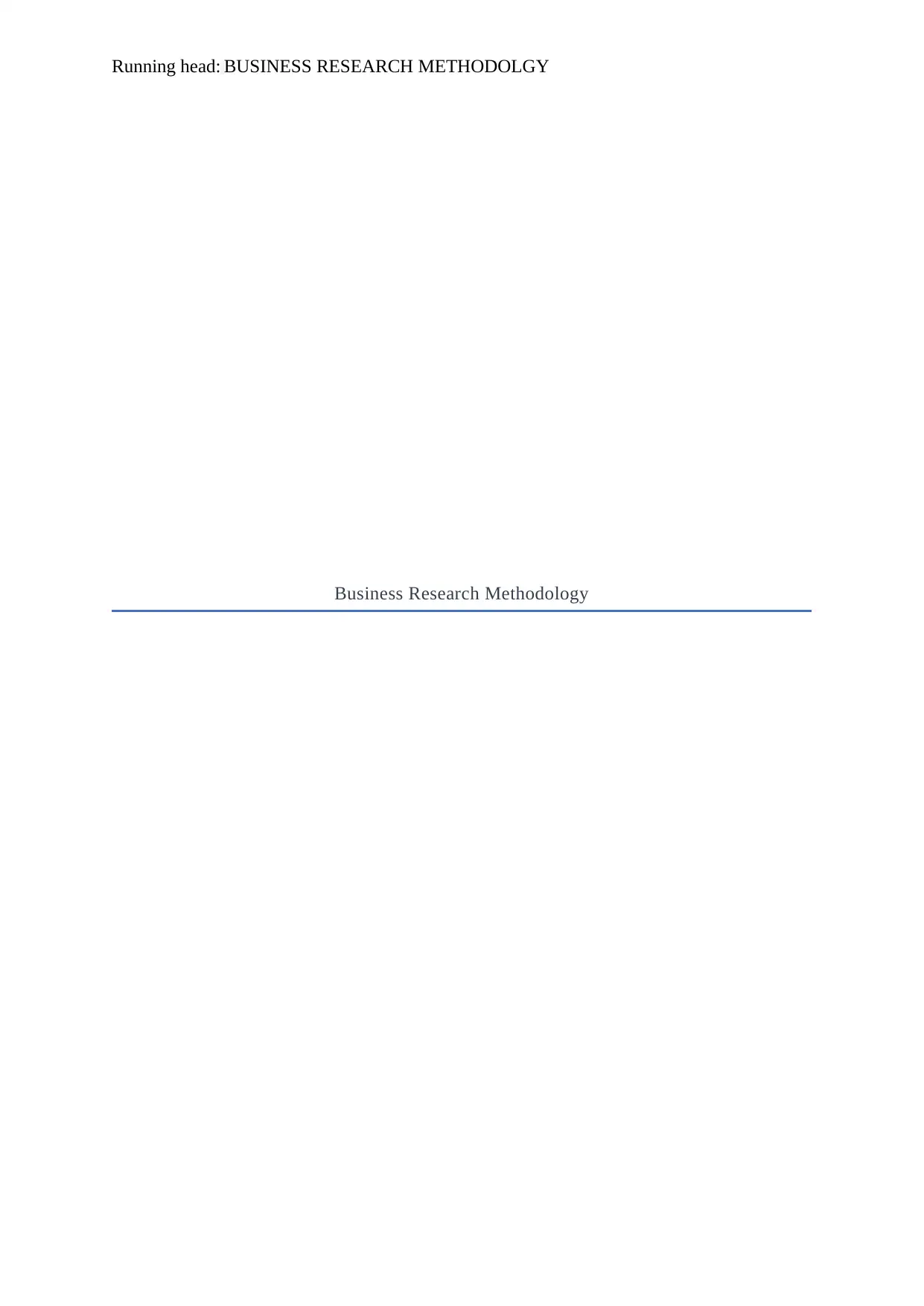
Running head: BUSINESS RESEARCH METHODOLGY
Business Research Methodology
Business Research Methodology
Paraphrase This Document
Need a fresh take? Get an instant paraphrase of this document with our AI Paraphraser
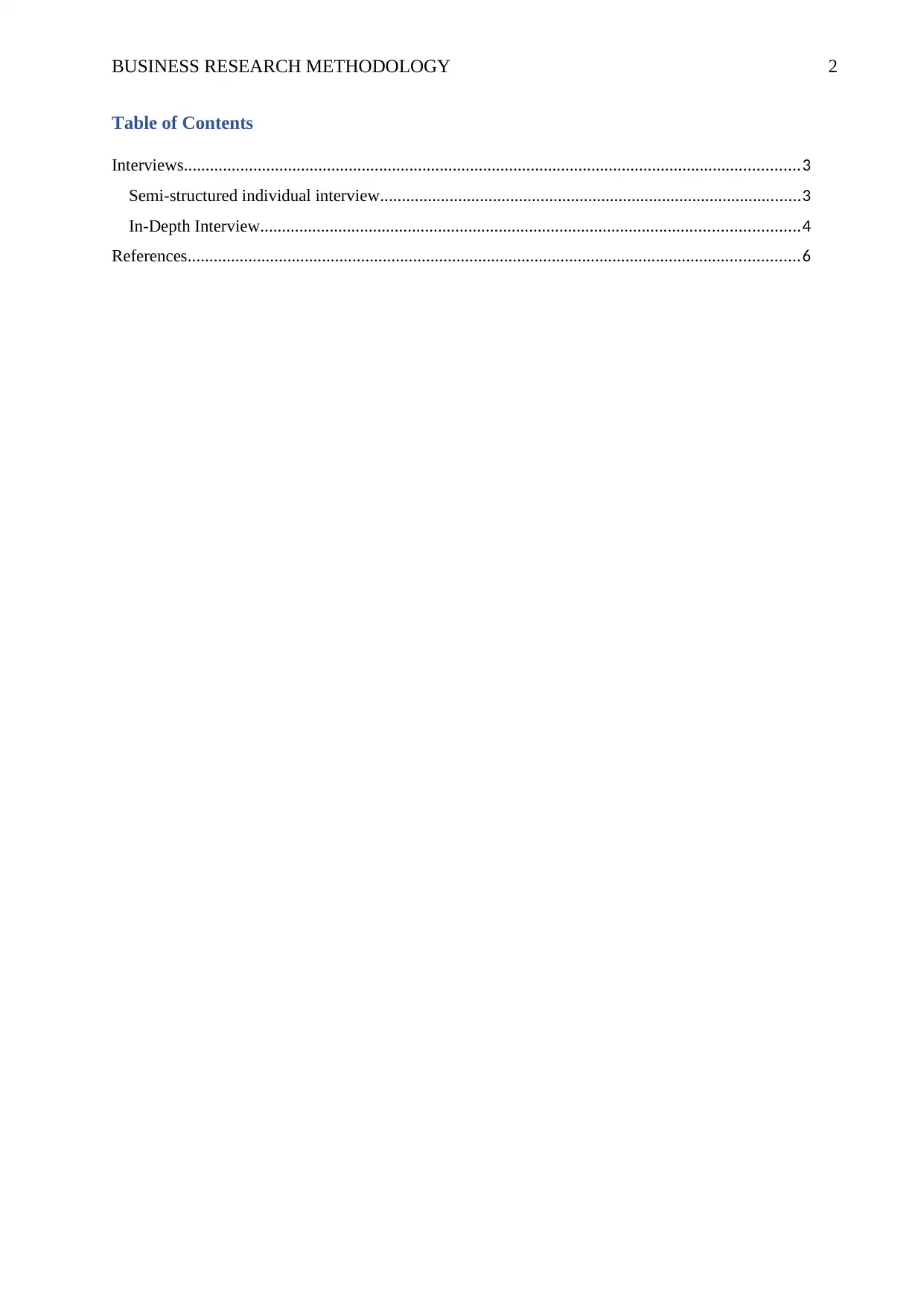
BUSINESS RESEARCH METHODOLOGY 2
Table of Contents
Interviews..............................................................................................................................................3
Semi-structured individual interview.................................................................................................3
In-Depth Interview............................................................................................................................4
References.............................................................................................................................................6
Table of Contents
Interviews..............................................................................................................................................3
Semi-structured individual interview.................................................................................................3
In-Depth Interview............................................................................................................................4
References.............................................................................................................................................6
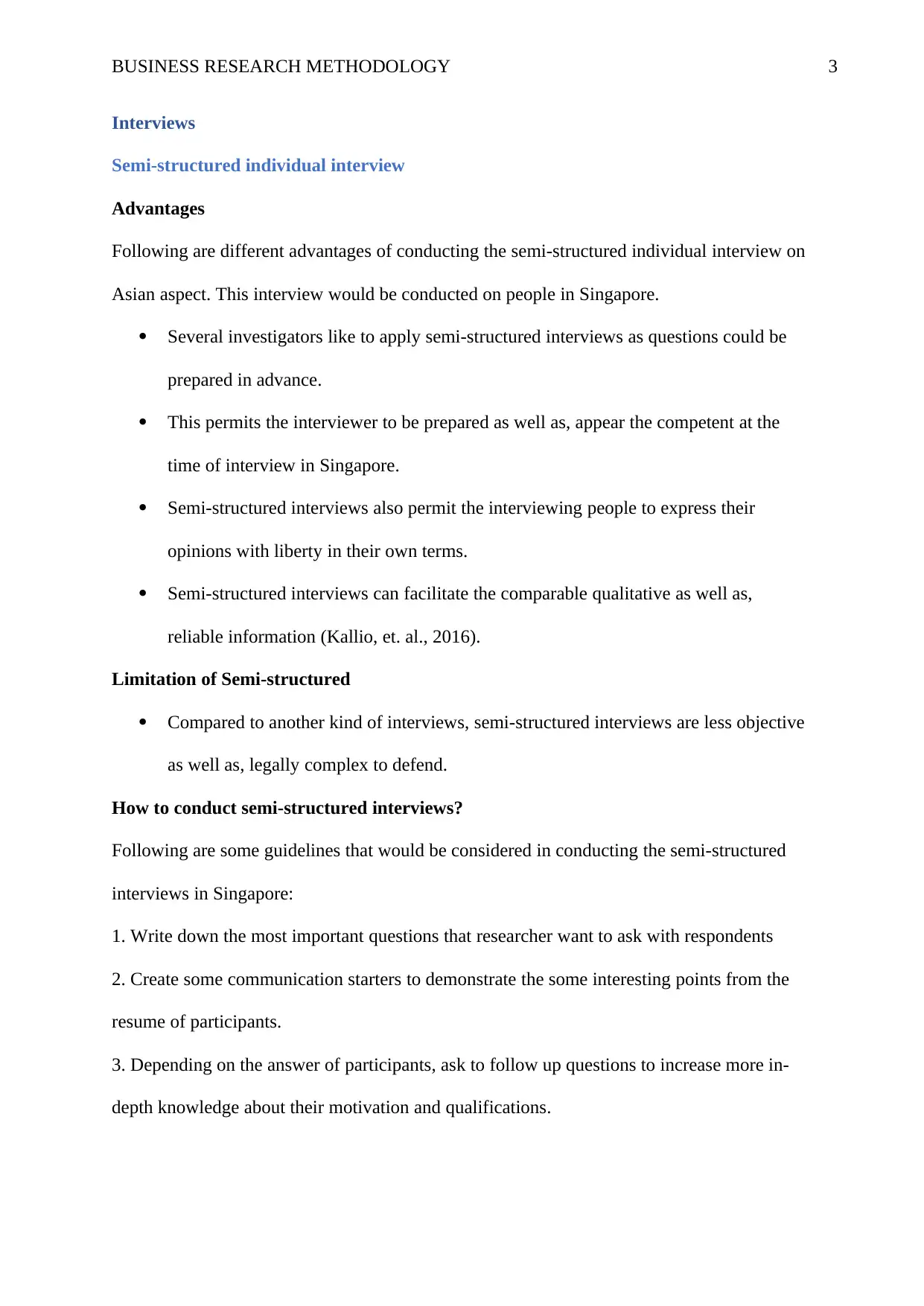
BUSINESS RESEARCH METHODOLOGY 3
Interviews
Semi-structured individual interview
Advantages
Following are different advantages of conducting the semi-structured individual interview on
Asian aspect. This interview would be conducted on people in Singapore.
Several investigators like to apply semi-structured interviews as questions could be
prepared in advance.
This permits the interviewer to be prepared as well as, appear the competent at the
time of interview in Singapore.
Semi-structured interviews also permit the interviewing people to express their
opinions with liberty in their own terms.
Semi-structured interviews can facilitate the comparable qualitative as well as,
reliable information (Kallio, et. al., 2016).
Limitation of Semi-structured
Compared to another kind of interviews, semi-structured interviews are less objective
as well as, legally complex to defend.
How to conduct semi-structured interviews?
Following are some guidelines that would be considered in conducting the semi-structured
interviews in Singapore:
1. Write down the most important questions that researcher want to ask with respondents
2. Create some communication starters to demonstrate the some interesting points from the
resume of participants.
3. Depending on the answer of participants, ask to follow up questions to increase more in-
depth knowledge about their motivation and qualifications.
Interviews
Semi-structured individual interview
Advantages
Following are different advantages of conducting the semi-structured individual interview on
Asian aspect. This interview would be conducted on people in Singapore.
Several investigators like to apply semi-structured interviews as questions could be
prepared in advance.
This permits the interviewer to be prepared as well as, appear the competent at the
time of interview in Singapore.
Semi-structured interviews also permit the interviewing people to express their
opinions with liberty in their own terms.
Semi-structured interviews can facilitate the comparable qualitative as well as,
reliable information (Kallio, et. al., 2016).
Limitation of Semi-structured
Compared to another kind of interviews, semi-structured interviews are less objective
as well as, legally complex to defend.
How to conduct semi-structured interviews?
Following are some guidelines that would be considered in conducting the semi-structured
interviews in Singapore:
1. Write down the most important questions that researcher want to ask with respondents
2. Create some communication starters to demonstrate the some interesting points from the
resume of participants.
3. Depending on the answer of participants, ask to follow up questions to increase more in-
depth knowledge about their motivation and qualifications.
⊘ This is a preview!⊘
Do you want full access?
Subscribe today to unlock all pages.

Trusted by 1+ million students worldwide
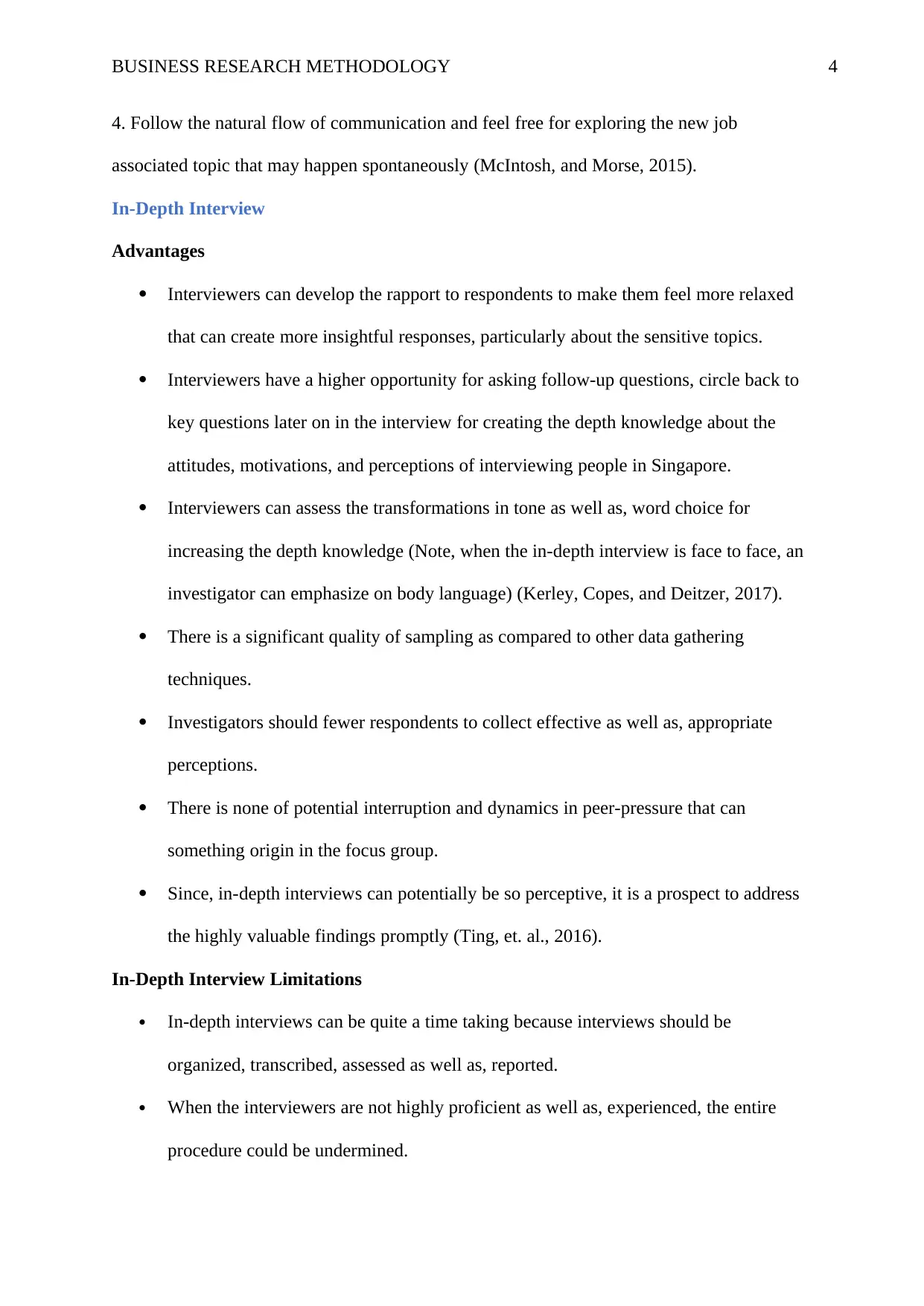
BUSINESS RESEARCH METHODOLOGY 4
4. Follow the natural flow of communication and feel free for exploring the new job
associated topic that may happen spontaneously (McIntosh, and Morse, 2015).
In-Depth Interview
Advantages
Interviewers can develop the rapport to respondents to make them feel more relaxed
that can create more insightful responses, particularly about the sensitive topics.
Interviewers have a higher opportunity for asking follow-up questions, circle back to
key questions later on in the interview for creating the depth knowledge about the
attitudes, motivations, and perceptions of interviewing people in Singapore.
Interviewers can assess the transformations in tone as well as, word choice for
increasing the depth knowledge (Note, when the in-depth interview is face to face, an
investigator can emphasize on body language) (Kerley, Copes, and Deitzer, 2017).
There is a significant quality of sampling as compared to other data gathering
techniques.
Investigators should fewer respondents to collect effective as well as, appropriate
perceptions.
There is none of potential interruption and dynamics in peer-pressure that can
something origin in the focus group.
Since, in-depth interviews can potentially be so perceptive, it is a prospect to address
the highly valuable findings promptly (Ting, et. al., 2016).
In-Depth Interview Limitations
In-depth interviews can be quite a time taking because interviews should be
organized, transcribed, assessed as well as, reported.
When the interviewers are not highly proficient as well as, experienced, the entire
procedure could be undermined.
4. Follow the natural flow of communication and feel free for exploring the new job
associated topic that may happen spontaneously (McIntosh, and Morse, 2015).
In-Depth Interview
Advantages
Interviewers can develop the rapport to respondents to make them feel more relaxed
that can create more insightful responses, particularly about the sensitive topics.
Interviewers have a higher opportunity for asking follow-up questions, circle back to
key questions later on in the interview for creating the depth knowledge about the
attitudes, motivations, and perceptions of interviewing people in Singapore.
Interviewers can assess the transformations in tone as well as, word choice for
increasing the depth knowledge (Note, when the in-depth interview is face to face, an
investigator can emphasize on body language) (Kerley, Copes, and Deitzer, 2017).
There is a significant quality of sampling as compared to other data gathering
techniques.
Investigators should fewer respondents to collect effective as well as, appropriate
perceptions.
There is none of potential interruption and dynamics in peer-pressure that can
something origin in the focus group.
Since, in-depth interviews can potentially be so perceptive, it is a prospect to address
the highly valuable findings promptly (Ting, et. al., 2016).
In-Depth Interview Limitations
In-depth interviews can be quite a time taking because interviews should be
organized, transcribed, assessed as well as, reported.
When the interviewers are not highly proficient as well as, experienced, the entire
procedure could be undermined.
Paraphrase This Document
Need a fresh take? Get an instant paraphrase of this document with our AI Paraphraser
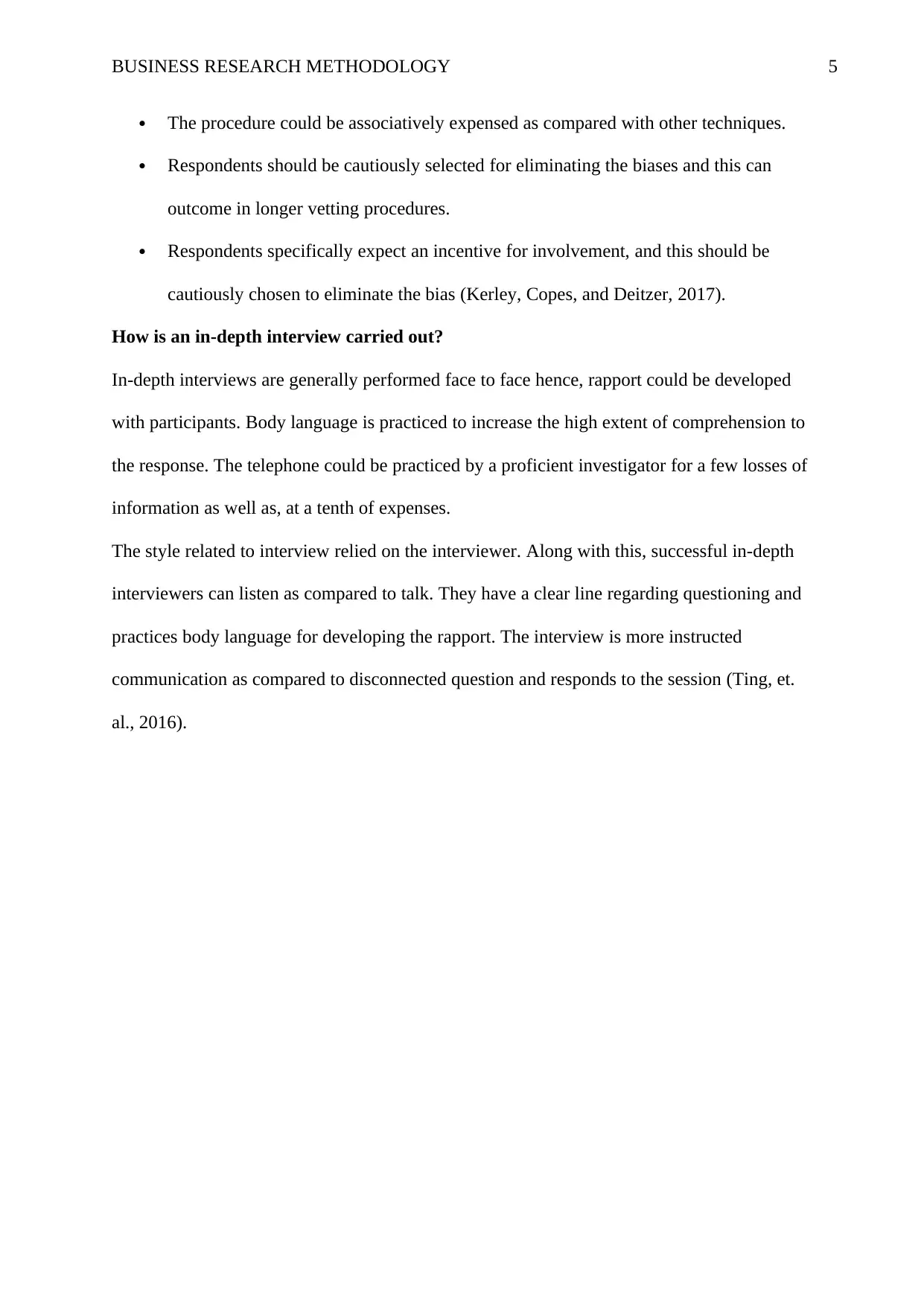
BUSINESS RESEARCH METHODOLOGY 5
The procedure could be associatively expensed as compared with other techniques.
Respondents should be cautiously selected for eliminating the biases and this can
outcome in longer vetting procedures.
Respondents specifically expect an incentive for involvement, and this should be
cautiously chosen to eliminate the bias (Kerley, Copes, and Deitzer, 2017).
How is an in-depth interview carried out?
In-depth interviews are generally performed face to face hence, rapport could be developed
with participants. Body language is practiced to increase the high extent of comprehension to
the response. The telephone could be practiced by a proficient investigator for a few losses of
information as well as, at a tenth of expenses.
The style related to interview relied on the interviewer. Along with this, successful in-depth
interviewers can listen as compared to talk. They have a clear line regarding questioning and
practices body language for developing the rapport. The interview is more instructed
communication as compared to disconnected question and responds to the session (Ting, et.
al., 2016).
The procedure could be associatively expensed as compared with other techniques.
Respondents should be cautiously selected for eliminating the biases and this can
outcome in longer vetting procedures.
Respondents specifically expect an incentive for involvement, and this should be
cautiously chosen to eliminate the bias (Kerley, Copes, and Deitzer, 2017).
How is an in-depth interview carried out?
In-depth interviews are generally performed face to face hence, rapport could be developed
with participants. Body language is practiced to increase the high extent of comprehension to
the response. The telephone could be practiced by a proficient investigator for a few losses of
information as well as, at a tenth of expenses.
The style related to interview relied on the interviewer. Along with this, successful in-depth
interviewers can listen as compared to talk. They have a clear line regarding questioning and
practices body language for developing the rapport. The interview is more instructed
communication as compared to disconnected question and responds to the session (Ting, et.
al., 2016).
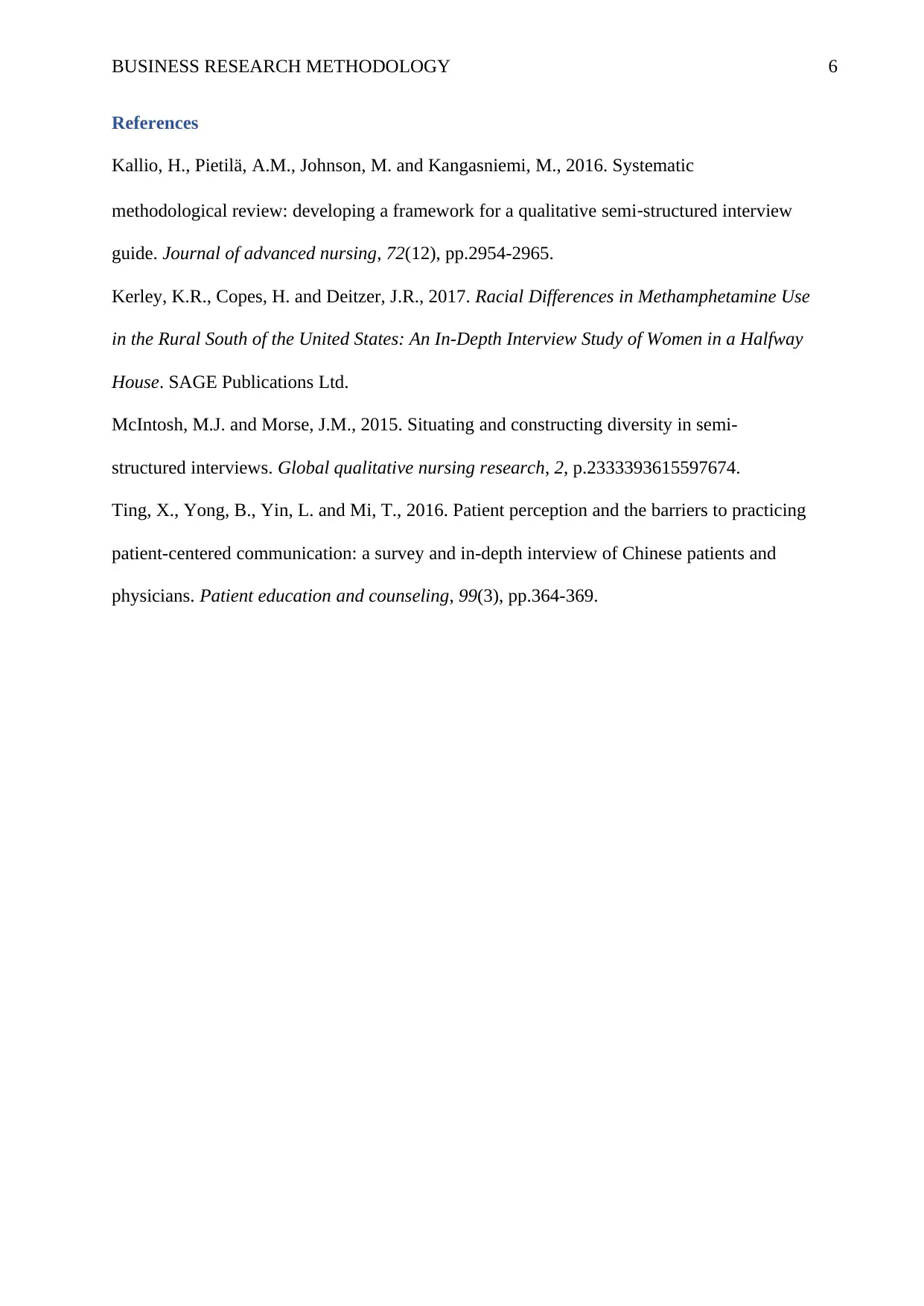
BUSINESS RESEARCH METHODOLOGY 6
References
Kallio, H., Pietilä, A.M., Johnson, M. and Kangasniemi, M., 2016. Systematic
methodological review: developing a framework for a qualitative semi‐structured interview
guide. Journal of advanced nursing, 72(12), pp.2954-2965.
Kerley, K.R., Copes, H. and Deitzer, J.R., 2017. Racial Differences in Methamphetamine Use
in the Rural South of the United States: An In-Depth Interview Study of Women in a Halfway
House. SAGE Publications Ltd.
McIntosh, M.J. and Morse, J.M., 2015. Situating and constructing diversity in semi-
structured interviews. Global qualitative nursing research, 2, p.2333393615597674.
Ting, X., Yong, B., Yin, L. and Mi, T., 2016. Patient perception and the barriers to practicing
patient-centered communication: a survey and in-depth interview of Chinese patients and
physicians. Patient education and counseling, 99(3), pp.364-369.
References
Kallio, H., Pietilä, A.M., Johnson, M. and Kangasniemi, M., 2016. Systematic
methodological review: developing a framework for a qualitative semi‐structured interview
guide. Journal of advanced nursing, 72(12), pp.2954-2965.
Kerley, K.R., Copes, H. and Deitzer, J.R., 2017. Racial Differences in Methamphetamine Use
in the Rural South of the United States: An In-Depth Interview Study of Women in a Halfway
House. SAGE Publications Ltd.
McIntosh, M.J. and Morse, J.M., 2015. Situating and constructing diversity in semi-
structured interviews. Global qualitative nursing research, 2, p.2333393615597674.
Ting, X., Yong, B., Yin, L. and Mi, T., 2016. Patient perception and the barriers to practicing
patient-centered communication: a survey and in-depth interview of Chinese patients and
physicians. Patient education and counseling, 99(3), pp.364-369.
⊘ This is a preview!⊘
Do you want full access?
Subscribe today to unlock all pages.

Trusted by 1+ million students worldwide
1 out of 6
Related Documents
Your All-in-One AI-Powered Toolkit for Academic Success.
+13062052269
info@desklib.com
Available 24*7 on WhatsApp / Email
![[object Object]](/_next/static/media/star-bottom.7253800d.svg)
Unlock your academic potential
Copyright © 2020–2025 A2Z Services. All Rights Reserved. Developed and managed by ZUCOL.





